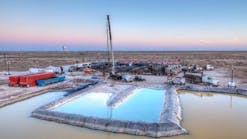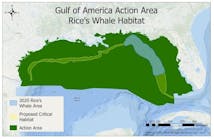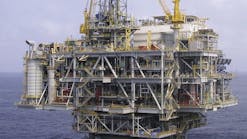C. Russell LuigsOil service companies benefit more from rising hydrocarbon demand tied to steady prices than from elevated oil prices.
Global Marine Inc.
The cost of energy has remained low enough to stimulate tremendous growth in demand, while remaining high enough to allow producers to earn attractive profits. "The enemy is $40/bbl oil, not $14/bbl oil," in that $40/bbl oil would stifle worldwide demand and promote inflation.
History lessons
Many analysts, oil and gas executives, and investors believe that rising oil prices are good for the oil service industry. This theory, which contradicts fundamental economics, is based on the myth that people will always need oil and will pay any market price.Unfortunately, the industry has been brutally reminded over the past 10 years that for any price level, there is also a corresponding level of demand. From the end of World War II up to the 1973 Arab oil embargo, U.S. oil demand increased from 5.5 million bo/d to 17.0 million bo/d. During this time, wellhead prices remained stable at just above $3/bbl.
Following the Arab oil embargo, oil prices rose dramatically, resulting in an immediate decline in demand. Several years later, demand grew modestly, but the 1980 Iran/Iraq war sent prices soaring again and demand slumped to pre-embargo levels (Fig. 1[21,872 bytes]).
These high-energy prices caused consumer behavioral changes. Economy cars replaced large sedans, energy-saving appliances became common, and relatively frivolous uses of energy, such as excessive heating, cooling, and lighting were discouraged. In addition, alternate sources of energy received tax credits and increased government support.
In the 1970s, the drilling boom increased production, and by 1983 capacity exceeded worldwide demand by 37% (Fig. 2 [20,116 bytes]). During the early 1980s, enormous volumes of potential production were held off the market, in an effort to sustain artificially high prices. For example, Saudi Arabia reduced its production from 10 million bo/d to 2 million bo/d.
At the same time, a bubble of excess natural gas developed in the U.S. Given the excess production capacity for both oil and gas, the need to drill more wells or to contract for drilling equipment and services was sharply curtailed. To meet recovering demand, producers simply turned on the taps. From 1983 to 1993, approximately 60% of the growing hydrocarbon demand, excluding the Former Soviet Union (FSU), was met by reopening shut-in production (Fig. 3 [32,655 bytes]).
Today, the oil service sector has made a dramatic recovery. Capital expenditures budgets are growing in proportion to the rising demand for oil and gas. As a result, demand for oil field equipment and services is also rising. Hydrocarbon prices are still a bargain for consumers. Few products can be purchased for less than $1.50/gal, not even milk, fruit juice, or spring water.
Price-driven demand
For the last 10 years, other than during the 1990 Persian Gulf War, the 1993 Metallgesellschaft AG trading fiasco, and a short demand/inventory squeeze in the winter of 1996 (Fig. 4), West Texas intermediate oil prices have traded within the $17-21/bbl range. Worldwide hydrocarbon consumption, excluding the FSU, grew by 30%, an extraordinary gain in an extremely short period of time.Stable and moderate oil prices have stimulated this growth in consumption. There are concerns, however, that the demand for $20/bbl oil will overwhelm the industry's ability to meet that demand.
Many economists believe that hydrocarbon demand will continue to increase as developing countries become industrialized. Daniel Yergin, president of Cambridge Energy Research Associates, said recently, "In 2 years, Asia will overtake North America as the world's number one consumer of oil." In particular, countries like China, with huge populations are becoming major oil importers.
Based on extrapolating the trend over the past 10 years, consumption is expected to increase another 30% by 2006. Thus, worldwide hydrocarbon demand, excluding the FSU, is expected to rise from 93 million bo/d in 1996 to 121 million bo/d in 2006. Assuming that existing production depletes at a rate of only 2.5%/year, we will need 50 million bo/d equivalent from new sources within 10 years.
Just-in-time
In the recent past, meeting demand was largely a matter of bringing shut-in reserves on-line. However, there are now minimal shut-in reserves to fall back on. Excess production capacity is only 3% of the world's present consumption. OPEC is probably within 3 million bo/d of currently sustainable deliverability, while non-OPEC countries are producing wide open.Production is being brought on-stream "just-in-time," each year managing to add enough capacity to meet rising demand. Over the next 10 years, 90% of the new supplies will have to come from drilling new wells (Fig. 3b).
Activity is up
The industry has already responded to the increase in demand. Worldwide exploration and production (E&P) expenditures are driven by hydrocarbon demand (Fig. 4 [23,887 bytes]), not prices, provided that price averages remain above the threshold of adequate producer profitability. While West Texas intermediate prices have averaged in the $19/bbl range since 1990, upstream capital expenditures have nearly doubled.In the Gulf of Mexico, 1997 lease sales reached an all-time high with bids on 1,032 blocks. Unfortunately, there has been insufficient drilling in the last decade to maintain reserve levels in the Gulf, even with higher activity. Although production is up 25%, reserves have declined 30%.
Prices have not increased within the last 10 years, and E&P companies are still reporting improved profitability. Lower operating costs and improved concession terms have increased discretionary cash flow. The industry benefits from dramatic advances in technology: fewer dry holes are drilled because of 3D seismic technology, and well economics have improved through steerable-drilling and enhanced-recovery techniques.
In addition, the world's political environment is more receptive to drilling activity. With the end of the Cold War, more countries are moving toward market-based economies. Governments are competing vigorously for capital, offering more desirable concession terms and discovering that there are internationally competitive limits to taxation.
Capacity constraints
Although capital budgets are growing, future drilling activity will be restricted because rig supply is limited. The enormous oversupply of mobile offshore drilling rigs from the mid-1980s has dwindled to almost zero. Over the last year, only a few rigs have remained idle, and in many cases, these rigs are only marginally capable of drilling.Today, the offshore drilling fleet's effective utilization rate is more than 98%, and the prospect of a net rig supply increase in this century is negligible. Vivid memories from the 1980s bust have created concern that the industry may again over-build and will push rig supply and demand out of balance.
Current orders for mobile offshore drilling rigs total only 5% of active supply. Because drilling rigs require 1.5-3.0 years to construct, scheduled additions to the worldwide mobile rig supply for the next 4 years will barely equal deletions, resulting in no-net change (Fig. 5 [21,978 bytes]).
Meanwhile, waiting lists for rigs are becoming long. The waiting period for a deepwater semisubmersible in the Gulf of Mexico is more than 2 years, and for premium jack ups, 6 months and longer.
In 1982, Global Marine's contract backlog consisted of long-term contracts negotiated in an effort to minimize the negative impact of the drilling slump. This strategy helped the company survive. Currently, short-term contracts are preferable to long-term contracts because of rising day rates.
Rig shortages are not the only problem. All types of oil field equipment and services are in short supply. Experienced people are equally scarce, since the industry failed to hire an entire generation of workers and gave early retirement packages to many experienced personnel.
Rising rig rates
As drilling equipment becomes harder to obtain, increased pressure will be placed on day rates, shattering the myth that day rates depend on oil and gas prices. In reality, day rates are a function of the supply and demand for the rigs themselves.The rate for third-generation semisubmersibles in the North Sea has increased from $30,000/day in 1994, to $155,000/day in mid-1997. In West Africa, the rate for premium jack ups capable of operating in 300 ft of water has increased from $25,000/day in 1995, to $75,000/day in mid-1997. In the Gulf of Mexico, the day rate for a jack up that can operate in 250 ft of water has increased from $12,000/day in 1993, to currently over $50,000/day.
During the same period of time, oil prices have remained relatively flat. Rig prices are not set by drilling contractors but by oil companies through the bidding process. Therefore, rigs gradually migrate to the highest bidders, who are typically the operators with the best prospects.
New-build justification
Global Marine Inc. tracks current offshore day rates as a percentage of estimated day rates required to justify speculative building of new rigs, without firm, long-term contract commitments from operators. New-construction day rates are calculated as the sum of daily cash operating costs plus a capital recovery factor of $700/day per million dollars invested.The data are collected and analyzed according to rig type and region in order to monitor the relative condition of rig markets. The regions include the U.S. Gulf of Mexico, the North Sea, West Africa, and Southeast Asia. Rig types include various classifications of jack ups and floating rigs.
Global Marine publishes these results on the third Monday of each month in a summary of current offshore rig economics (Score). The July release of the June 1997 worldwide Score reported that day rates averaged 64% of the rate needed to justify speculative new construction. Although this is short of the benchmark of 100%, it is still a 101% change from 5 years ago, and a 16% change from 1 year ago (Table 1 [80,149 bytes]). Because of elevated rig building costs, the June Score rose only 0.6% from May.
Scarce shipyard capacity, a shortage of skilled construction labor, and long delivery lead-times for key rig components increase the cost of building new rigs and lengthen delivery schedules. Capacity constraints are delaying rig deliveries currently under construction, and shipyard prices are rising for new orders.
For example, the cost to build a modern drillship capable of operating in 7,000 ft of water increased from $220 million 1 year ago, to almost $300 million today. In addition, estimated construction time increased from 18 months to 30 months. As a result, the day rate expected to generate speculative new orders for these rigs rose from $195,000 1 year ago, to $225,000 today. For a new drillship, the day rate most contractors want under a 5-year drilling contract rose from $150,000 1 year ago, to $200,000 today.
Although the Score is up to 70% for jack ups and 60% for semisubmersibles, day rates will have to go much higher before contractors take the risk of ordering additional rigs based on speculation. If the Score achieves 100%, many people fear that construction activity will result in an oversupply similar to what happened in the 1980s. Although this could happen, there are several factors that are different for the current cycle.
In the 1970s, the industry did not take a conservative approach to growth. As a percentage of the existing fleet, rigs on order were as high as 65% in 1974, and after a downturn in 1977 to 7%, returned to 50% in 1981.
In the early 1980s, approximately 60% of the rigs on order were built without contracts. Fig. 6 [32,000 bytes] shows that the current market outlook resembles the period 1955-1981, rather than 1982-1995, indicating that the last 10 years may have been an aberration.
Meeting customer demand
To meet current customer demand, Global Marine is expanding its fleet through acquisitions and conversions. At current day rates, Global Marine will only undertake a major conversion or new construction in conjunction with a long-term contract (3-5 years). This is necessary to reduce risk and guarantee pay-back on the majority of the investment.Two of the conversions under way are estimated to cost $200 million each. Each rig has an average contract length of 4 years that will return two thirds of the capital with a 15% rate of return. So far, Global Marine has been unable to negotiate contracts that would justify building new rigs. Because new-build construction costs are high and delivery times are long, it is less expensive and faster to convert a hull. Unfortunately, hulls suitable for conversion are becoming scarce.
Global Marine's strategy has been to search for quality-rig acquisitions. Over the past 5 years, the company has acquired 10 rigs. The first 6 rigs were cantilevered jack ups, capable of drilling in 300 ft of water. The last 4 rigs were semisubmersibles or drillships that have deep-water capabilities.
Global Marine has also upgraded the water-depth capability of one of its arctic-class semisubmersibles from 1,800 ft to 3,000 ft. The company expects that approximately 40% of its 1998 contract drilling revenues and 50% of its contract drilling operating cash flow will come from deepwater rigs. In total, Global Marine has a fleet of 31 rigs, including the recent additions of the Maersk Vinlander and Maersk Jutlander.
Although it is difficult to predict what the future holds, it is clear that the E&P industry is facing a tremendous challenge. There are concerns that operators will not be able to drill enough wells to keep up with the demand for $20 oil and that service companies will not be able to keep up with the operators' needs for rigs, equipment, and personnel. If we fail to do so, oil prices will rise sharply, demand for hydrocarbons will decline, and the boom/bust cycle will recur.
Acknowledgment
Special thanks to Lisa Elliott for her help in compiling this article.The Author
C. Russell Luigs is the chairman and CEO of Global Marine Inc. Before joining Global Marine in 1977, he was the president and CEO of U.S. Industries Inc. He is a member of the National Society of Professional Engineers and the American Institute of Mining, Metallurgical & Petroleum Engineers. He is also a director of the International Association of Drilling Engineers. Luigs graduated from the University of Texas in 1957 with a bachelor's degree in petroleum engineering.
Copyright 1997 Oil & Gas Journal. All Rights Reserved.



